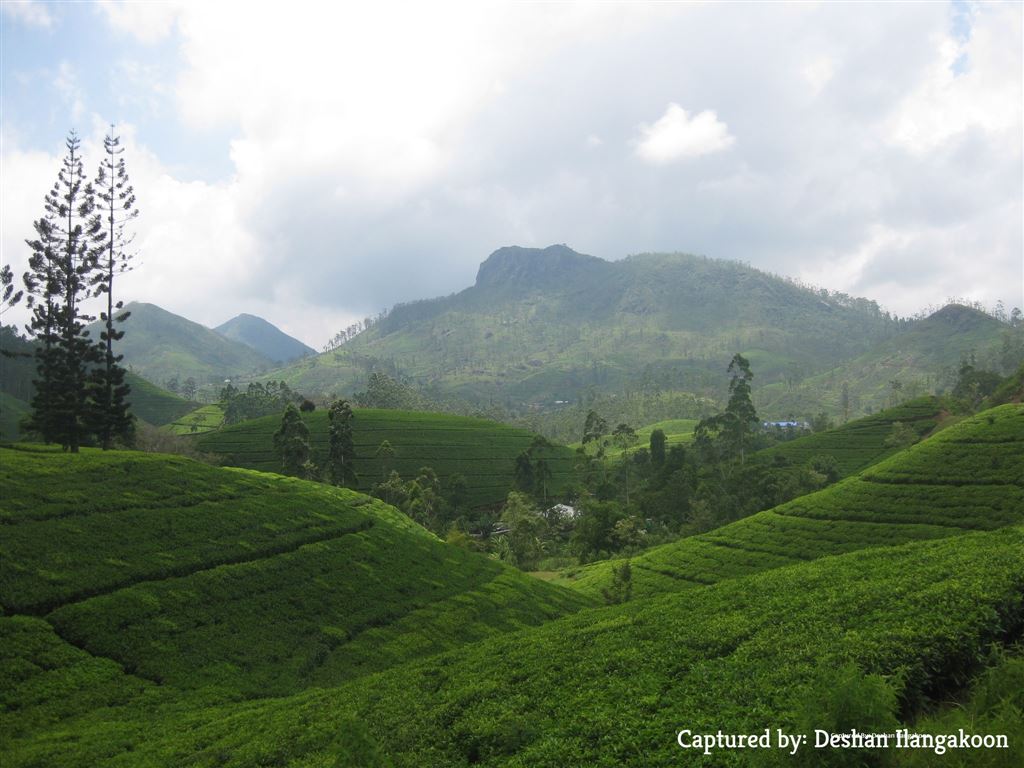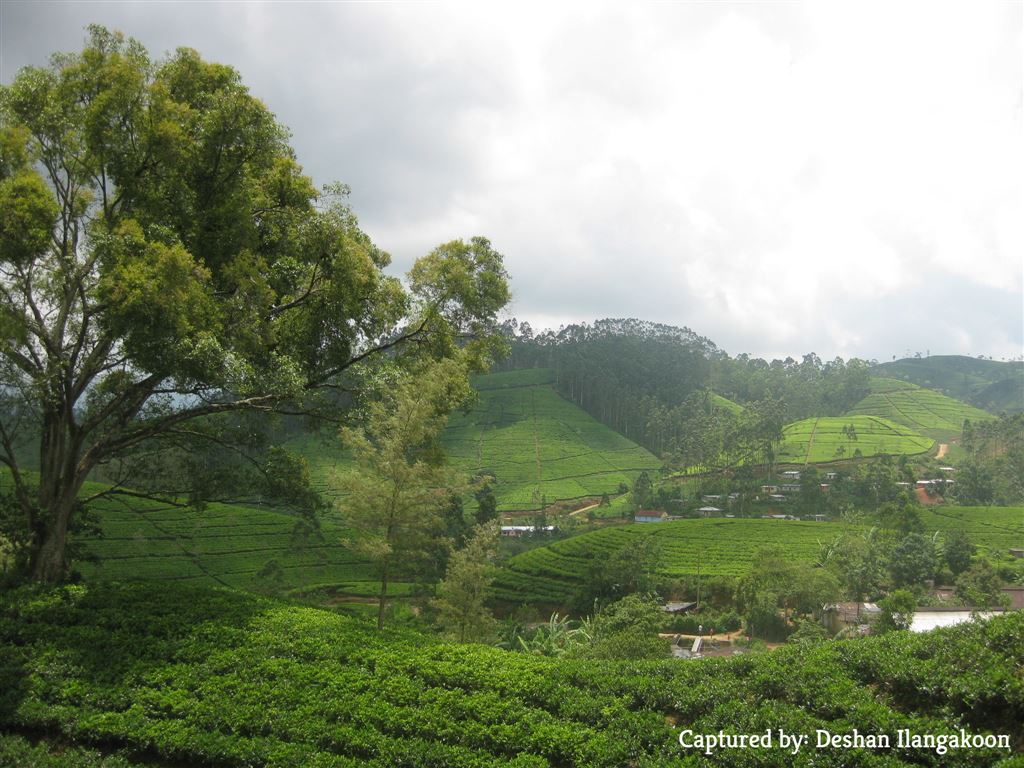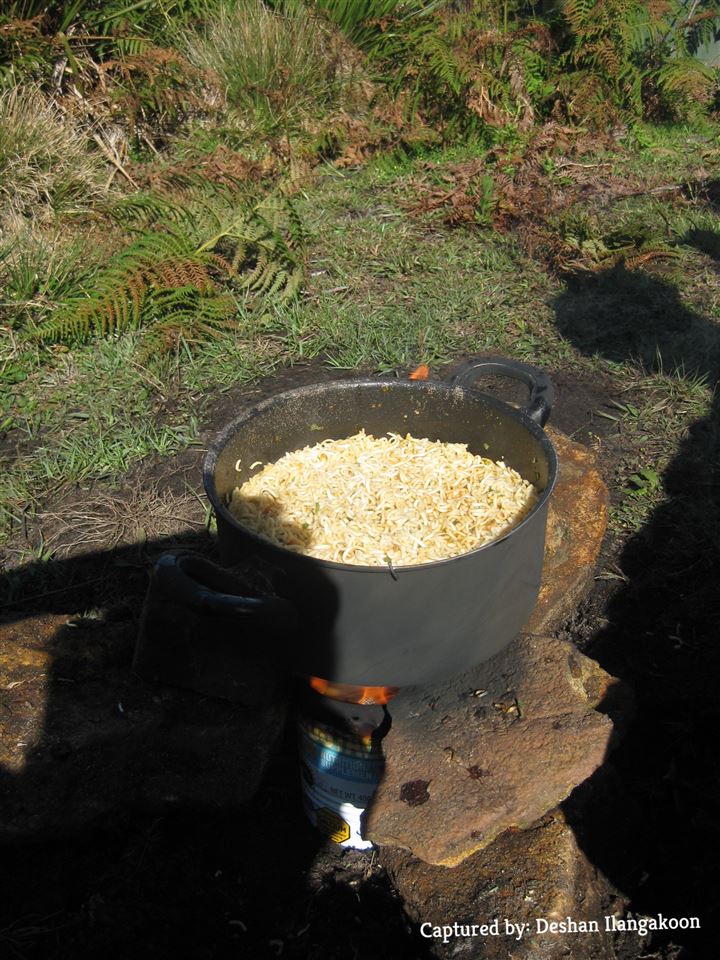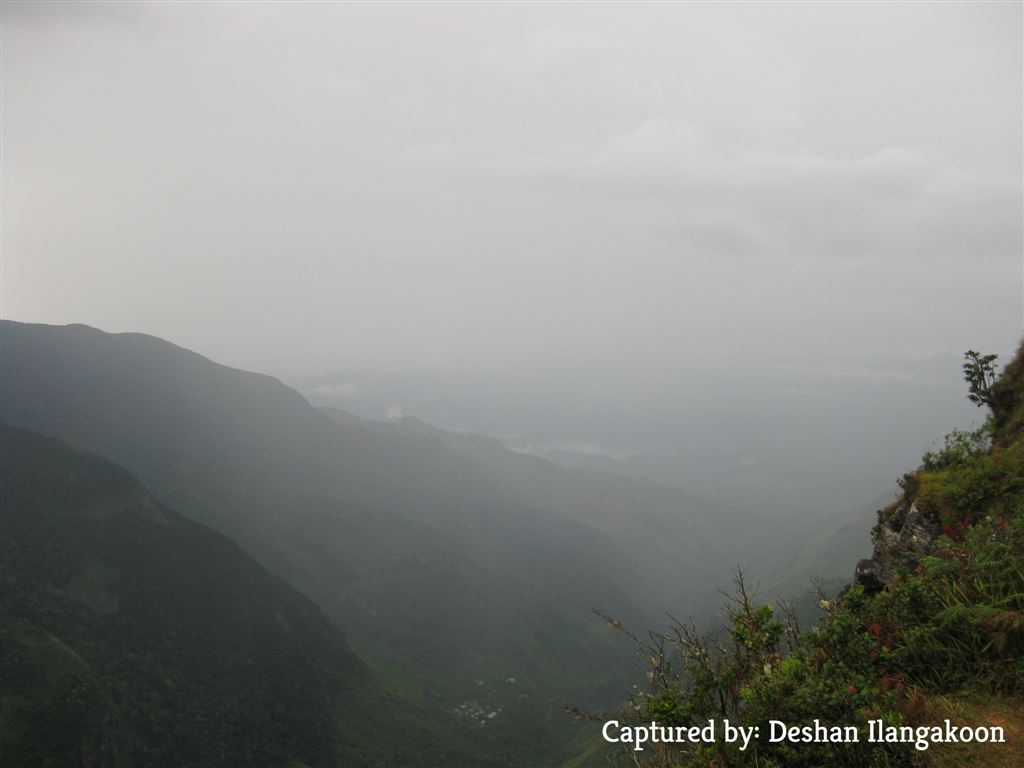For anyone who loves the great outdoors and loves camping, this is one of the most beautiful places to visit. In sunny Sri Lanka’s hill country, from its sheltered position in the mountain tops, is the Horton Plains National Park. The plains lie at a cool altitude between 6,900 and 7,000 feet. The plains are about 20 miles from the major city of Nuwara Eliya.
 Tea Plantations
Tea Plantations
For a camping expedition one must always travel light, packing only the bare essentials in clothing and minimal cooking utensils and provisions. With our backpacks loaded our journey would begin at the busy Fort Railway station in Sri Lanka’s capital city Colombo. To see the full sites on the trip up, we booked seats in the observation cart of the intercity train to Badulla. When traveling to the hills of Sri Lanka, riding in the observation cart is one of the best ways to soak in the country’s beautiful landscape. This is the last carriage in the train and has comfortable seats and wide windows all around giving its passengers a nearly unobstructed 270-degree view of the scenery.
The Start of the Journey
In order to make camp before nightfall, we took the early morning train which left the station at around 6 am (punctuality is optional with these trains). You also have the option to take the overnight train, which will get you to Ohiya station by around 8 in the morning but you will miss the scenery. The start of the journey takes the train through some of the busy cities in Sri Lanka as it heads out of the urban jungles towards the rural forests and hills of Sri Lanka. The train runs alongside small villages and main roads for most of its journey until it approaches the famous Kadugannawa climb. This climb marks the start of the train’s climb to the hills of Sri Lanka. The train tracks, cut out by the British during the colonial rule of the country, twist and wind its way up the sides of the mountains. As the train climbs higher it runs through a multitude of tunnels carved out of the mountain. A common practice for people at this point is to put their heads out and scream to the horn of the train’s diesel engine. This is not recommended much, as the tunnel is pitch black and there is no warning of how close the walls of the tunnel are to the train. Also given that these trains are powered by a diesel engine it’s highly likely you will end up with a black soot mask on your face.
As the climb continues, the trees on the sides of the hill space out to reveal why Sri Lanka is called a Paradise Island. The scenery truly begins after the train has passed the hill city of Peradeniya. Here on the train travels through the country’s vast tea plantations and the little towns which have emerged around them.
 The Train
The Train
As the train lumbers along the twists and turns through the mountains, you see many fellow passengers with heads out the windows enjoying the fresh cold breeze blowing along past the train. The train climbs slowly up the countryside, occasionally stopping at a few quaint little stations that were built centuries ago along with the original rail tracks. These stations were built mainly to service the needs of nearby plantations. Some of these little stations have a little trick of taking you back in time to when they were first built: a time of horse carriages and people in tailcoats and top hats or long gowns with elegant gardens hats.
As the train travels past each of these stations, if you look out onto the passing platforms, you get to view another remnant of the old British rail system. This is the old token system used to grant a train passage onto a single line of the track. The purpose of this system is simply to make sure that two trains don’t end up on the same single line heading in the opposite directions since only one token is used between for a single stretch of track. This old system has absolutely no modern modifications and not been updated since the tracks were originally built. However, this is probably because it is such a robust system and there is no need to worry about system downtimes or outages.
How this operates is with tokens. These are heavy metal weights in a leather pouch, which has a very large stiff leather oval ring. As the train approaches a platform of the station, the driver throws his ring neatly onto the extended arm of the first station master. Next as the train approaches the end of the platform, the driver stretches out his hand as another station master throws a new token ring on to the driver’s hand. This technique has been well mastered by the drivers and station masters alike, as they can perform this feat without needing the train to slow down at all.
The Hiking Begins and the Beauty of Horton Plains Reveals Itself
The marvels of the train ride come to a close as you approach the station of Ohiya. This station, just a few walls, and a roof does not reveal any details of the adventure about to begin. From this point, it’s about 12 kilometers to the campsite, of which about 6 or 8 kilometers is an uphill walk along a winding plantation road. When we stepped off the train, it was around 2 in the afternoon. However having eaten snacks from the street vendors, who hop in and out of the train, we were all set to start our trek. The climb up the first leg of the hike offered no view and is a tough hike. Our reward, however, was soon to come. The hike builds the hype up slowly. You realize you are getting closer from the fact that the trail starts to level off. It is then that we come to the outer entrance of the park. Here we showed our camping permits, we received this before our trip from the wildlife department in Colombo. After quickly freshening up we were way to the next leg of the trip. By this time it was about 4 in the evening and the sun was pretty low. As we started we were still to see the true beauty of the park. But slowly Horton plains started to show her true beauty.
As we walked, the trees started to get smaller and further apart. Between the trees, we could see sneak peeks of the plains. Then finally the track opens up and we get to marvel at the beauty of Horton Plains. As it's about 5 in the evening and the sun is beginning to set behind the hills, but it still shines a soothing orange light over the plains. All around us, the plains stretch out. In the distance, we see the mountains that stand guard around this treasure. We keep marching on. A cool breeze hits us. This feels like the cold wet towels you are given at hotels when you first arrive. The beauty of this place is one that is truly a marvel of nature. We keep going on. Soon we get our first view of the wildlife of the park. Herds of Sambar roam the plains around us. They are the largest species of deer on the island and can be almost as tall as a man. Among these heard stand the male bucks. They stand guard, as the rest of the herd graze on, keeping a watchful eye on us.
 The Plantations and their little villages
The Plantations and their little villages
Receiving Directions to the Campsite and Warnings
Finally, we reach the camp office. Here we show the camping permit and are given directions to the campsite and a warning. We are strictly advised to make sure no plastic is thrown in the park. They advise, stating that each campsite has a waste bin to which we can toss our litter. We were also strictly warned against having any campfires as the plains were basically grasslands and we could set it ablaze. Our final warning was that playing music and drumming was strictly forbidden, so as not to disturb the animals.
Once all this was done we set out on the short hike to the campsite. We made haste as we were running late and it was starting to get dark. The park has three campsites which are simply known by their numbers. The campsites are on a gentle slope with Campsite One being at the bottom and closest to the main walking trail. Campsite Two is close to One but a little further up the slope. Finally, campsite three is the furthest up the slope and also the furthest from the main track. This campsite is the best of the three as it offers a slightly bigger space. The location of Campsite Three also makes it slightly hidden from the main trail, giving its occupants some privacy. Despite the varying sizes of the campsites, the set maximum number of people allowed in each site is 10. Each site has a high walled cement pit where plastic waste can be discarded without the worry of animals eating it. Each campsite also has a toilet. This, however, is basically a cement shack over a squatting pit. This means that a bucket and a roll of toilet paper is a must for each visit to flush and wipe up.
Tips Once You are at the Campsites
When traveling here always remember you are sleeping in the open and you cannot have a fire for warmth. Therefore always make sure you have plenty of warm clothes and blankets. If not you are going to have some very long, miserable and freezing nights.
Cold as the nights are, they do offer something else. If you are able to bear the cold for a bit and you step out, you can enjoy the true magnificence of the universe, because as far as the eye can see is a vast unspoiled canopy of stars. This beauty almost makes you want to sleep outside. However don't, unless you are ok with becoming a Popsicle.
 Tea plantations
Tea plantations
It is important, I believe at this point, to give a warning. This is a national park and wild animals live here. This is why camp rules dictate that no one can walk around the park after sundown. While the plains are breathtaking and the Sambar majestic, there are also leopards. These big cats are masters of stealth and hunt mainly during the night and it is ill-advised to travel anywhere at night inside the park, especially alone. Now, this being said the chances of them walking into camp is never heard of. These are very elusive creatures and prefer the cover of trees. They will avoid human contact as much as possible. However, for the safety of all, you are not allowed to wander the plains after six. This means you are confined to the camp from that time onwards.
A Night on the Plains
A night on the plains is very cold and wet. It didn’t rain much during our visit, however, it drizzled through most nights, so accidentally touching the side of the tent made sure to wake you. As said before warm clothes are a must. However there is a catch, you have to find a good balance between warmth and weight. Given that and taking into consideration the long hike at the start, what we did was to tie the jackets around our waist while traveling to help offload some weight. Next, you should make sure you carry at least one pair of warm socks for the night and preferably a way to cover your ears.
The sleeping arrangement was pretty simple, sleep as close as possible to the next person without making it awkward. Now if you’re traveling with a special someone else, you just got an awesome excuse to get super cozy. If so, you may not have much use for the war clothes in that case.
The First Morning on Horton Plains
The next morning, Horton Plains had another treat for us. The grass fields were sparkling golden as the early morning sun hit the dew drop covered grass plains. To add to the beauty, a light ground mist lay in patches, adding a little mystery to the magic of this whole place.
 The Morning light
The Morning light
 Morning on the plains
Morning on the plains
You get to see this in full scope when you head towards the main office and the canteen area. This area is on a slightly raised ground gives the perfect view. As you reach the top, beyond the car park area stretches out the plains. This sight is truly spectacular. These are the same plains you would have hiked across if you arrive from Ohiya as we did. If you get to the canteen area at about 6 or 6:30 in the morning, the view you see is mind-bogglingly beautiful. You also have the additional advantage of not having the view spoiled by any visitors. If you are lucky you will also get to see one of the Sambar up close and personal, as there is one buck that likes to make regular visits to the canteen, looking for handouts.
 Misty Hills
Misty Hills
 The misty plains at dawn
The misty plains at dawn
The Freezing Cold Morning Wash and Breakfast
The morning wash at these campsites is a little fun that will guarantee you are awake afterward, no matter how sleepy you are. For washing purposes and actually for drinking purposes as well, the campsites are located near a large stream that cuts across the plains. The campsite is near, what are called, the chimney pools. These are a set of small pools that the water collects in before heading on its way. The water is freezing cold and clear. A quick wash of the face, or if you are more daring, a dip in the water will make sure you completely forget the tiredness of the day before.
 The little light blue tent is our campsite next to the chimney pools
The little light blue tent is our campsite next to the chimney pools
For breakfast you have two options, eat at the canteen or make your own. On our trip, we experimented with both options and each had its own merits. At the canteen you have a decent spread of either pastries or some staple local meals like string hoppers. If you are cooking yourself on the plains you have the thrill of feeling like a real outdoorsman.
We used an old trick learned from Scout camps, the tin can cooker. This was because you must remember; you are not allowed to have open campfires for fears of starting a forest fire. The way this is done is to take an old tin can and punch holes near to the top of the can (about an inch or two below the rim). With this done, fill the can about two-thirds of the way to the top (below the hole line obviously) with kerosene. After this, you put some old rags on the top, so that it will float above the kerosene (make sure the rags are soaked in the kerosene first though). Build yourself a small rock platform to keep the dish on top of and light the rags on fire. This will mean that the rags keep soaking in the kerosene and burning while the line of holes around the top of the can provide the ventilation for the fire. This way you get to have a safe and contained fire. The only drawback is the food can get some of the taste and smell of the kerosene fire.
 Tin can cooker
Tin can cooker
You are presented with two options, as to how you can spend the day. Option one is the traditional option picked by about all the visitors to this place. This is a hike around the park, seeing its main attractions. The walk will take you to see the plains famous waterfall called Baker’s fall. With a viewing platform and the waterfall close behind, this is a perfect place to get some great group photographs. However, it isn’t allowed for one to try and bath here since the rocks are extremely slippery and not at all safe.
View From the World's End!
The next sites that this trail offers are the two World’s ends. These are sheer vertical drops off the side of the mountain. The two world’s ends are named Big and Small for the size of the drop. The two sites have a platform raised to provide a safe footing but there is no protective guard rail. It’s important to remember that when looking over, the drop is most definitely fatal. From this perch, you get to see the valley below. These cliffs mark the end of the mountain range on its side of the plains, so as far as you can see, are all the flatlands of Sri Lanka. On a clear day, you can actually make out the lakes and rivers, the vast paddy cultivations and the scattered groups of villages and town. Again this is another great opportunity for group photographs and even landscape photographs.
 View from worlds end
View from worlds end
 The way down
The way down
These two sites are the main attractions on the main trail of the park. The trail winds around the park, letting you see the parks beautiful diversity in vegetation. It cuts across both the grass plains and the forests of this park. The paths are dirt roads and when it rains it is tricky to navigate as you get running streams of water and the ground becomes very muddy. A good pair of hiking shoes will go a long way in helping you out with this track. Also, bring water and something to eat is a good idea. You have to remember to avoid bringing plastic items, as the park rangers at the entrance do a regular check on any bags for any litter.
More Excursions and Hikes at Horton Plains National Park
The second excursion that you can undertake is the hike to Kirigalpoththa mountain summit, the second tallest mountain in Sri Lanka. The hike is a 7 kilometer (one way) hike from the parks office. However don’t ever let this small distance fool you. The hike is a tough and grueling excursion. It is recommended for only those most determined. For the hike, you can get a ranger or guide to take you, and this is recommended as the path sometimes is not so obvious to follow. The climb will take you through all that the plain has to offer which are the good and the bad. The recommended time of year for this is January to March but it is also possible from June to August.
The hiking trail goes through some tough terrain. The last stretch to the top is along a narrow ridge. This ridge is made more dangerous according to the day’s weather conditions, as it is prone to sharp gusts of very strong winds. Again this trek is not for the armature and the faint-hearted. However, the view from the top is a reward unto its own.
With these two excursions covered the trip back down to Colombo seems docile. Coming down one can choose to hire out a vehicle, which has come with some other visitors, to take you down back to the Ohiya station. However, unless you have managed to buy the observation cart tickets ahead of time (the Ohiya station doesn’t sell observation cart tickets) it is the regular coaches for you. Given that this is the only train from Badulla, it is almost always full by the time the train gets to Ohiya (around noon). A better option would be to head to Nuwara Eliya and take the intercity bus to Colombo. You can take the train itself as it stops at the Nanuoya station (which is for Nuwara Eliya) and takes the bus into town. In the inter-city A/C buses, a seat is guaranteed and you don’t have to worry about it being overcrowded like the train.
Anyone who takes this camping trip will never be left short for memories and great anecdotes. The plain amplifies why Sri Lanka is such a beautiful country. I would definitely recommend this journey to any outdoor lover. But one thing you must always remember is that you should, “take away nothing but memories and pictures and leave behind nothing but your footprints”.